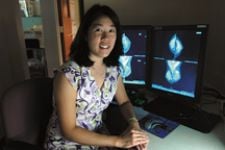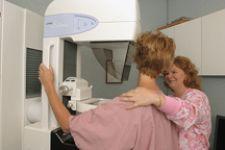
Digital mammography requires no films and no processing. A lot of the time previously used for analog mammography has been given back to the patients.
Windsong Radiology Group in upstate New York has grown from humble beginnings into one of the busiest imaging centers in the United States.
Founded in 1987 by Janet Sung, M.D., Windsong has built its practice and reputation on a philosophy based on two simple rules: provide exceptional patient care and base that care on giving patients access to the best technology available.
Rule One: Exceptional Patient Care
Coming from a large, hospital-based radiology department, Dr. Sung saw the need for a practice that was more intensely focused on the patients and their needs, especially in the area of women’s imaging.
This patient centered philosophy is evident in every aspect of Windsong Radiology; from workflow to décor, everything is devoted to making the patient’s visit easier, shorter and more comfortable.
Dr. Sung believes that one of the best ways to put a patient at ease is with timely communication. “Patients should not be left to wonder after an imaging study if an abnormality had been found. That’s why I insist we tell the patient right away if we’ve noticed any problems or if everything looked OK.”
“Knowing right away decreases the patient’s anxiety,” said Anna Chen, M.D., breast radiologist and a partner in the practice.
Rule Two: Offer Patients the Best Technology Available
The cornerstone of patient care at Windsong is ensuring that patients have access to the best technology and equipment on the market. “We are known for being the first to market with new technology,” said Kiebzak. “We were the first to offer stereotactic biopsies, the first to offer MRI biopsies. And we were the first to offer digital mammography.”
When physicians at Windsong began their quest for a better digital mammography system. Their search settled on the Selenia digital mammography system from Hologic.
Selenia Makes the Grade
“We initially installed only one Selenia to see how we liked it,” said Blatto.
“Now,” Kiebzak continued, “we have three Selenia units running…and we’re taking delivery on five more units beginning in August of 2007. The main reason we’ve gone with Selenia is because of the quality of the image.”
“The image quality is excellent. The contrast is wonderful and the resolution is excellent,” said Dr. Chen. “We are picking up a lot more microcalcifications — calcifications that were not well seen before.”
Digital mammography has reduced a lot of the time previously required for analog mammography, giving the technologists more time to see additional patients.
“With analog,” Kiebzak said, “the workflow was very time consuming. We were only doing 150 mammograms a day.” The new Selenia systems have allowed the practice to expand to an average of 220 mammograms a day.
Suros Biopsy Systems
Windsong was the first practice in the area to offer their patients MRI-guided breast biopsies, something, the managers admit, was only made possible by the introduction of the Suros ATEC biopsy system from Hologic.
Kiebzak said, “We were waiting for someone to bring to market a breast biopsy technology that was right for MRI biopsies. The ATEC system is just what we were waiting for.”
Blatto agrees with her co-manager’s assessment of the Suros system. “Honestly, they were the only ones out there with this kind of technology,” she said. “While there are other competitors on the market now, to me, Suros – and Hologic – will always be the top.”
The technology managers have found that the ATEC system fires easily and handles well, resulting in more complete samples and less patient discomfort.
“We compared systems for both MRI and stereotactic biopsies,” said Dr. Chen, “and the Suros systems were much faster. Suros equipment requires smaller incisions and allows for more local anesthetic to the site” — two features that significantly reduce a patient’s discomfort during the procedure.
Working with Hologic
“Hologic has shown a lot of interest in us,” Kiebzak said, “and they have shown that they really care about everything, from start to finish – from sales and service, to installation, applications and support.”
“They give me a real warm and fuzzy feeling,” Blatto said, acknowledging that her description may seem a bit unusual when talking about a medical device manufacturer. “They really care. They always want to know what they can do to make our lives easier, to make the technology work faster, how they can improve the user-experience.”
“We had the first Selenia unit installed two years ago,” Kiebzak added, “and Hologic is constantly following up about it, asking how things are going, if everything is o.k. They are always looking for input into how they can improve the user experience.”
Improvements through Input
This consistent follow-up with end-user allows Hologic to make frequent improvements and upgrades to their technologies based on professional input.
In fact, the technology managers at Windsong were asked to provide critical assessments for the latest Suros breast biopsy technology before the device was even brought to market.
“We met with the engineers from Suros about their new Celero device,” said Kiebzak. “They wanted our opinions and input on it before it came out.”
“They actually incorporated all of our suggestions before they brought the final product out on the market.” Blatto said. Celero is now the first vacuum assist spring loaded core device to receive FDA clearance for use with ultrasound-guided biopsies, something that might not have been possible without the input from doctors and technologists at Windsong Radiology.



 December 17, 2025
December 17, 2025 









